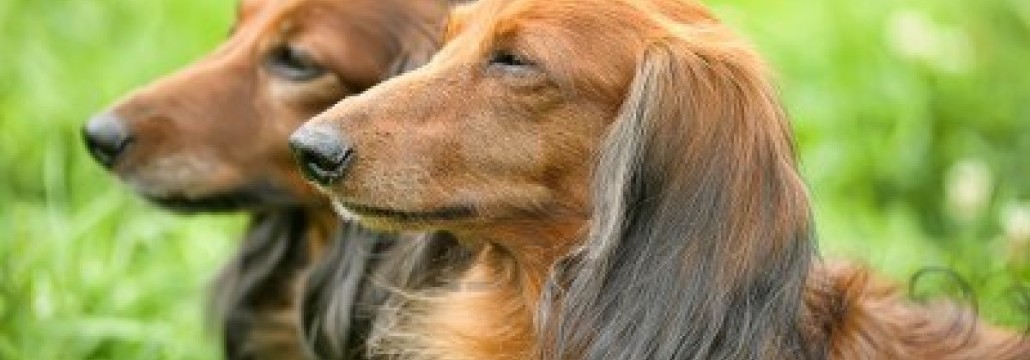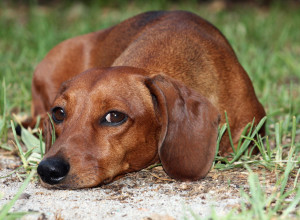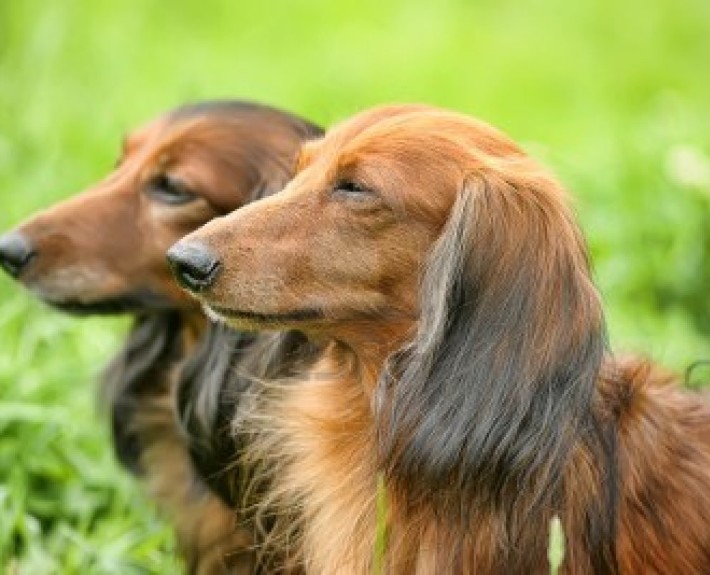Dachshund

Woof!
A typical dachshund is long-bodied and muscular, with short, stubby legs. Its front paws are unusually large and paddle-shaped, for extreme digging. One dachshund was known to have dug a 10-meter (33 ft) hole to catch its unsuspecting prey. Long coated dachshunds have a silky coat and short featherings on legs and ears. It has skin that is loose enough not to tear while tunneling in tight burrows to chase prey. The dachshund has a deep chest that provides increased lung capacity for stamina when hunting prey underground. Its snout is long with an increased nose area that absorbs odors.
In 5 Words
- Lively
- Playful
- Devoted
- Clever
- Stubborn
SnapShot
Males – 20 to 27 cm (8 to 11 inches)
Females – 13 to 18 cm (5 to 7 inches)
Weight:
Males – 7.3 to 15 kg (16 to 32 lb)
Females – 3.6 to 5.0 kg (8 to 11 lb)
Origin: Germany
Life Span: 14 – 17 Years
Colour: Chocolate & Cream, Red, Black & Tan, Blue, Cream, Tan,Black, Chocolate
Litter Size: 4 to 8 puppies
Characteristics
Learn About the Dachshund
The Dachshund breed origin I came across some interesting facts about Dachshund history . It seems that dogs of similar statute to the dachshund may have been around for a very long time, depicted in, rock and tomb drawings etc some thousands of years old, found in countries such as Egypt, South America and China, but the dachshund we know now, seems to have originated in Germany over 400 years ago. The Dachshund originated in Germany as a hunting dog. Though the breed’s origins can be traced as far back as the 15th century, the breed development really began in 17th century Germany. Called Dachshunds, or “badger-dogs,” these short hounds did just that – hunted badgers. Further development of the breed created two sizes. The standard size continued to hunt badgers as well as wild boar, while the miniatures pursued hare and foxes.
By the 18th century hunters had shorted the legs in the hunting hounds by selective breeding. Thus producing the standard Dachshund. Standard dachshunds were used in packs to hunt and catch wild boar and to go into badger dens. The Dachshund would chase the badger out of the den and corner it for the hunter. This helped the hunter because then the badgers were not attacking their horses. According to Dachshund history these small dogs first appeared in UK in 1840when Prince Consort received a number of smooth haired dachshunds from Prince Edward of Saxe-Weimar these dogs were kept at Windsor and took part mainly in pheasant shoots.
The first Dachshund dog show was in England in 1859, another royal to show interest in the Dachshund breed was Queen Victoria, her interest in dog shows improved the dachshund dogs popularity. The Dachshund Club of England was formed in 1881, and the German Deutscher Teckelklub was formed in 1888. The German breed standard was set in 1879. Registration of Dachshunds was included in an all-breed studbook even before the German Dachshund Club was founded. Eleven Dachshunds were included in the American Kennel Club’s Stud Book in 1885. Dachshunds rapidly gained popularity in America. The Dachshund Club of America was founded in 1895, and by 1914 Dachshunds were among the top ten breeds exhibited at the glamorous Westminster Kennel Club dog show.
The Dachshund is small sized dog with a long body, short legs and high bone density. It has a well proportionate head which tapers towards the tip of the nose; black or dark colored nose with wide nostrils; almond-shaped dark colored eyes which are medium in size; long hanging ears which are set on the top of the head and touch the cheek; muzzle is slightly domed; tightly stretched lips having teeth meet in a scissors bite; well padded feet are short and strong; medium sized tail is curved and a continuation of the spine.
The base of the neck slopes down to a protruding chest and a tighter abdomen, and the tail follows the line of the back.Miniature Dachshunds come in three varieties— smooth, longhaired and wire-haired—and colors can vary from solids of red, tan or yellow or combinations of chocolate, black and gray (among others). The dachshund is a short-legged, elongated dog breed, of the hound family. The standard size was developed to scent, chase, and flush badgers and other burrow-dwelling animals, while the miniature was developed to hunt smaller prey, like rabbits. In the American West, they have also been used to hunt prairie dogs.
The Dachshund is fearless, brave, rash, playful, determined and clever. He’s quite independent and stubborn because he was bred to hunt alone. He can be quite bossy and will take over the house if you let him. He’s a “one-man” dog and bonds more closely with one individual in the family. He likes to be in on everything you do and he will follow you everywhere (never againwill you go to the bathroom alone). He’s playful and will chase a ball (but he probably won’t bring it back). He can take a while to warm up to strangers and can be argumentative with other dogs. It’s in his instinct to dig and burrow so you’ll find him tunneled under blankets and pillows. He’s affectionate and likes plenty or cuddles and belly rubs.
He has a keen sense of smelland will wander off when he picks up an interesting scent so he should not be trusted off leash or unfenced. Lively, intelligent, courageous. With Children: long-haired are very good, wire-haired are good, smooth are fairly good and miniature only with older children. Make sure their first experience with children is positive. With Pets: Some co-exist peacefully, many are bossy, likes to dominate other dogs. Must be socialized when young to accept cats. Good family pet and hunting dog for above or below ground. Very good watch-dog. Very poor guard-dog.. The Dachshund has the tendency to become jealous, however can do very well with many other toy breeds in the home providing they are not snippy.
They are generally okay with other pets; however, once again, without proper leadership from their humans, they can be jealous, irritable, obstinate and very quick to bite, sometimes refusing to be handled. If you allow your little dog to take over your house, the dog will try his hardest to keep all of his humans in line—a weight which should not be placed on any dog’s shoulders, especially one as sweet as a little dog like the Dachshund. These negative traits are not Dachshund traits, they are small dog syndrome traits. Meaning, most owners treat their small dogs like babies, rather than giving them leadership, As well as rules they need to follow along with limits they are, and are not allowed to do, which all dogs instinctually crave. Dachshunds that have human leadership along with a daily pack walk are wonderful family companions with excellent temperaments.
This Breed health concerns may include sick sinus syndrome, patent ductus arteriosus, pattern baldness, cutaneous asthenia, immune-mediated thrombocytopenia, lipomas, liposarcoma,congenital deafness, intervertebral disc disease, atlantoaxial subluxation and a number of ocular disorders or conditions.
Some other Health Problems about Dachshund Dog:
- Intervertebral Disc Disease (IVDD). – Dachshunds are especially prone to having back problems. This may be due to genetics, moving the wrong way, or falling or jumping on or off furniture. Symptoms of a problem include an inability to raise up on the rear legs, paralysis, and sometimes loss of bowel and bladder control. It’s important to always support your Dachshund’s back and rear when holding him. Treatment may consist of anything from crate confinement with anti-inflammatory medications to surgery to remove the discs that are causing the problem or even confining the dog to a doggie wheelchair. Some owners have found that they can help ward off problems by taking their Dachshunds to chiropractors, acupuncturists, or rehabilitation therapists who have experience working with dogs.
- Epilepsy.- Dachshunds are prone to having epileptic seizes. In dogs that are affected, it’s thought that the condition is either genetic or brought about as the result of a fall or a hard blow to the head. If your Dachshund has seizures, take him to your vet to determine what treatment is appropriate. In many cases, epilepsy can be controlled with medication.
- Progressive retinal atrophy (PRA).- This is a degenerative eye disorder that eventually causes blindness from the loss of photoreceptors at the back of the eye. PRA is detectable years before the dog shows any signs of blindness. Fortunately, dogs can use their other senses to compensate for blindness, and a blind dog can live a full and happy life. Just don’t make it a habit to move the furniture around. Reputable breeders have their dogs’ eyes certified annually by a veterinary ophthalmologist and do not breed dogs with this disease. A DNA test for PRA is available for miniature longhaired Dachshunds.
- Gastric dilatation -volvulus (GDV) Also called Bloat or Torsion. This is a life-threatening condition that most often affects large dogs, but because of their deep chests, it also can affect Dachshunds. GDV occurs when the stomach is distended with gas or air and then twists (torsion). The dog is unable to belch or vomit to rid itself of the excess air in its stomach, and the normal return of blood to the heart is impeded. Blood pressure drops and the dog goes into shock.This is a medical emergency. Without immediate medical attention, the dog can die. Suspect bloat if your dog has a distended abdomen, is salivating excessively and retching without throwing up. He also may be restless, depressed, lethargic, and weak with a rapid heart rate. It’s important to get your dog to the vet as soon as possible. There is some indication that a tendency toward GDV is inherited.
- Cushings Disease (Hyperadrenocorticism). – This condition occurs when the body produces too much of a hormone called cortisol. It can be due to an imbalance in the pituitary gland or in the adrenal gland, or it can occur when a dog has too much cortisol from other conditions. The most common signs are excess urination and excess drinking. If your Dachshund exhibits these signs, take him to the veterinarian. There are treatments to help with this disease from the removal of a gland to medications.
- Canine Diabetes Mellitus (DM) -Diabetes is occasionally seen in Dachshunds, particularly if they’re overweight. Diabetes can be treated with diet and daily insulin injections. Signs include excessive urination and thirst and weight loss despite a ravenous appetite.
- Deafness– Hearing loss isn’t common in the breed, but it can occur in double dapple Dachshunds. Ask if the puppy and its parents were BAER (Brainstem Auditory Evoked Response) tested for hearing loss. This is not available in all areas but is available at most large specialty practices and teaching hospitals at veterinary schools. It can be done any time after the puppy is five weeks old.
- Obesity – It is important to watch your dachshund’s diet as you do not want your dog to get overweight, the extra weight puts strain on the spine and these dogs are predisposed to slipped or ruptured disks.Regular exercise should be a part of any dachshund health.
- Seizures – These may be diagnosed as epilepsy if the seizures are repeated and for no particular reason these may be controlled with medication.
- Mammary Tumors – These tumors in both male and female, spaying before the 1st heat cycle or neutering at an early age will reduce the risk of these tumors by 98% Most dogs have 5 mammary glands on each side 10 in total.The larger the breast tumor is the greater the risk of it spreading. Not all tumours are malignant almost 50% found are benign. Treatment often involves surgery also chemotherapy.
- Heart worm – Heart-worms are a major problem for all dogs so needs to be covered in this section on dachshund health problems, the development of heart worms can be a life threatening disease, that is caused by live worms in the heart, blood vessels and lungs. The heart worm larvae is carries by a mosquito who bites the dog, so infecting him. The larvae take several months to develop and start reproducing into the dogs blood stream.
- Acanthosis nigricans, unfortunately, seems to be unique to the Dachshund. It is characterized by dark, thick skin in Dachshund’s groin and armpits. While the genetic origin of the disease is unclear, it is certain that affected dogs are not to be bred. Vitamin E supplementation has been used to improve the condition, though no cure is known.
- Bloat —Bloat occurs when the stomach twists on itself, cutting off the blood supply to several organs. Without immediate treatment, bloat is fatal.
- Hypothyroidism —a disorder in which the thyroid doesn’t secrete enough of its hormone.
The Dachshunds come in three coat varieties, the smooth coated, long coat and wire-haired. However, this breed is low maintenance and only needs brushing to prevent tangles and mats from forming. Their ears must be kept dry at all times to prevent fungus, bacteria and mites. Brushing of the coat should be done on a regular basis to prevent tangling and/or matting. The Smooth Haired variety doesn’t require much grooming and would respond well to an occasional wipe down with a damp towel, or a harsh towel to remove any dead or loose hair.







